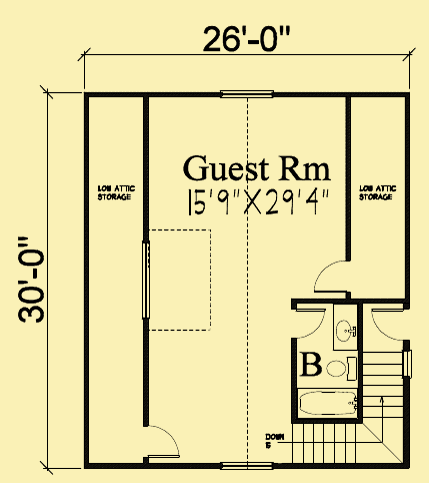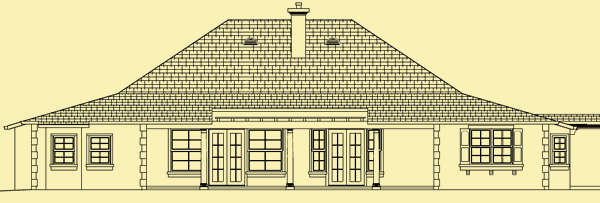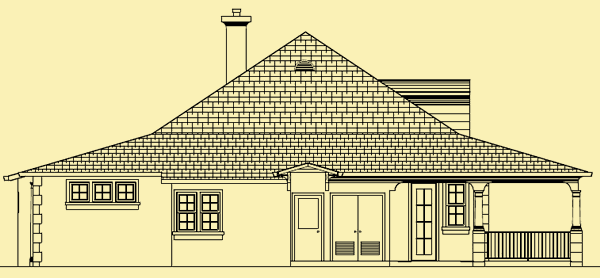Main Level Floor Plans For Classic French Country Style

Upper Level Floor Plans For Classic French Country Style


| Total Above-ground living area | 2563 |
| Main | 2563 |
| Lower level living area | |
| Footprint The dimensions shown are for the house only (indicating the smallest area needed to build). They do not include the garage, porches, or decks, unless they are an integral part of the design. |
76.5 W x 47.5 D |
| Above-ground bedrooms | 3 |
| Above-ground bathrooms | 2.5 |
| Master suite | Main |
| Lower-level bedrooms | 0 |
| Lower-level bathrooms | 0 |
| Stories | 1 |
| Parking | garage |
| Number of stalls | 3 |
| House height
Traditionally, the overall height of a house is determined by measuring from the top of the finished floor on the main level, to the highest peak of the roof.
|
23.5 |
| Ceiling heights Raising or lowering the height of the ceilings on one or more floors of a house is often a simple change that can be made by your builder. However, if you want to raise the ceiling of the main floor of a two-story home, there has to be room to add steps to the existing staircase. |
|
| Main level | 9 |
| Vaulted ceilings
We consider a room to be vaulted if the ceiling - whether flat, angled, or curved - is above 10 feet at its highest point. If you prefer that one or more rooms not be vaulted in your new home, this is a very simple change that your builder can make for you.
KEY TO SYMBOLS: LR = Living Room/Great Room DR = Dining Room FAM = Family Room FOY = Foyer STU = Study/Library/Den KIT = Kitchen SUN = Sunroom MBR = Master Bedroom MB = Master Bath LOF = Loft OFF = Office/Guest Room REC = Recreation/Game Room ALL = Entire Level |
LR, FOY |


This stunningly attractive one story home combines all the best elements of the French Country style. The classic front–and–rear facing roofline has eaves that flare at the junction with the outer walls, allowing for a huge covered space that spans the entire width of the house with deep patio spaces on either side. The muted tones of the stucco exterior allow the green shutters to stand out; the composition roof is a perfect background for two lovely dormers; and the round columns that outline the outdoor spaces add to the rustic yet elegant facade.
The entryway is set back 30″, allowing for shelves on either side and an arched opening above the front door. As you enter the vaulted foyer – created by the dormer you see in the photos, which also brings daylight into the space – your eyes are drawn to and through the great room straight ahead. After passing under a column–supported arched opening, the great room ceiling vaults from 10′ at the edges to 12′ down the center of the room, with decorative exposed wood beams on either side of the ridge. Two large windows on the far wall flank a glazed French door – all 8′ high – that opens to a wide and deep courtyard–style patio at the rear. A two–sided fireplace with arched openings on either side – all covered with stone veneer – visually separates the great room from the dining room. The dining room has a tray ceiling with the center area set at 10′, and a pair of glazed French doors flanked by windows open to the covered rear patio.
The kitchen is separated from the dining room by a gallery that leads to the master suite. However, a wall screens the dining room from the kitchen and nook, providing a more formal dining experience. The kitchen, like the remainder of the rooms in the house, has a 9′ ceiling (except where another dormer lets the ceiling rise and lets in additional daylight). It features a peninsula counter between it and a sunny breakfast nook, a large walk–in pantry, a window over the sink area, and plenty of counter space with cabinets above. The nook has an optional built–in bench in the corner, and a glazed French door that opens to a wide and deep patio space.
The gallery becomes a hallway that passes the powder room and the laundry room on your left as you approach the door to the garage, while on your right there’s a coat closet and the door to the master suite. Please note that the space in the hall that juts into the master bath area has a built–in countertop with cabinetry above it.
As you enter the suite, you pass a large walk–in closet with pull–down stairs that access the attic on your right and the bath on your left before entering the bedroom. This room features a trayed ceiling, and lots of glass on all three outer walls for light and views. Sliding glass doors on your right open to the rear patio. The bath has a vanity next to one of two separated sinks, a private toilet, and both a soaking tub beneath a corner wrapped in windows and an oversized shower.
Had you turned right from the foyer, you’d pass double doors that open to a media room before entering a hallway to two additional bedrooms. The media room/den has a wall of built–ins for a TV, a sound system, and cabinets, and a picture window provides views to the front. Both bedrooms have window bays large enough for desks, and plenty of windows on both outer walls for light, views, and cross–ventilation. They share a bath that has two separated sinks on either side before entering the toilet and shower area.
The detached garage is connected to the house via a breezeway. It has one roll–up door that accommodates two cars, and another that provides access to a space for a workshop or a small vehicle like a golf cart. There are windows on either side for light, and stairs in the corner bring you to the upper level. The unfinished upper level can be used as guest quarters or an office if you’d like, and there are access doors front and back that open to low attic storage spaces.
Please Note:
Due to licensing agreements, this house cannot be constructed within El Dorado County, California.




This lovely one–story home features large covered patios both in the front and in the rear. In fact the one at the front wraps around the edges to create a pair of open spaces large enough for furniture and entertaining. And the one at the rear – accessible from the great room, the dining room, and the master bedroom – is 12’–deep and 40’–wide, making it ideal for outdoor dining and relaxation. The great room has a vaulted ceiling, and it’s separated from the dining room by a two–sided fireplace. The 3–car garage is separated from the house by a breezeway, and there’s a guestroom above it.
We highly recommend that you click on two boxes – the number of bedrooms you know you need, and one less bedroom. For example, if you need 4 bedrooms, click on the boxes next to 4 and next to 3. Otherwise you will not see homes where existing rooms on the lower, main, or upper levels might work perfectly well as a bedroom instead of as an office, study, etc.
